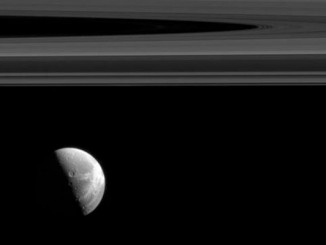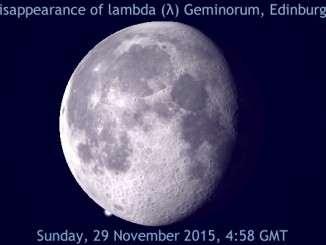
moon


See the Moon score a Bull’s-Eye, covering Aldebaran in Taurus on 23 December
Early on the evening of Wednesday, 23 December, observers in the British Isles can see the 13-day-old waxing gibbous Moon pass in front of first-magnitude Aldebaran — the ‘Eye of the Bull’ in Taurus — the brightest star to be occulted for UK observers in 2015. Here’s our observing guide to this readily observable event in large binoculars and small telescopes.

Lunar Reconnaissance Orbiter provides new high-resolution earthrise image
NASA’s Lunar Reconnaissance Orbiter (LRO) recently captured a unique view of Earth centred just off the coast of Liberia from the spacecraft’s vantage point in orbit around the Moon, about 83 miles above the crater Compton, which is located just beyond the eastern limb of the Moon, on the lunar farside.

Did the ancient Egyptians record the period of eclipsing binary Algol?
A scholarly investigation of the Cairo Calendar papyrus (1244–1163 B.C.) has led researchers at the University of Helsinki to conclude that the ancient Egyptians were aware that the variable star Algol (beta Persei) had a 2.85-day period. Given that the star’s current period is 2.8673 days, this supports the theory that mass transfer between the stars of this eclipsing binary has caused a long-term increase of its orbital period.

Saturn’s moon Prometheus seen up close
NASA’s Cassini spacecraft spied details on the pockmarked surface of Saturn’s moon Prometheus (86 kilometres, or 53 miles across) during a moderately close flyby on 6 December 2015. This is one of Cassini’s highest resolution views of Prometheus, a moon which orbits Saturn just interior to the narrow F ring, which is seen here at top.

Venus and the Moon guide you to Comet Catalina in the pre-dawn sky
Comet Catalina (C/2013 US10) is currently a morning object in Virgo low in the southeast before dawn twilight for UK observers. The comet has a photogenic close encounter with Venus and the waning crescent Moon on the mornings of 7—8 December, then rapidly heads north through the constellation Boötes for a closer brush with Arcturus on New Year’s Day.


See the Moon meet planet Jupiter on the morning of 4 December
In the dawn twilight of Friday, 4 December observers in the British Isles and Western Europe can see the 23-day-old waning crescent Moon just 2.5 degrees (half a 10×50 binocular field of view) below largest planet Jupiter in the constellation Leo high in the southern sky. And if you have a telescope, Jupiter’s largest moon plays hide and seek.

See star λ Geminorum’s lunar hide and seek on 29 November
Early risers in the northeast of England and Scotland with clear skies can see naked-eye star lambda (λ) Geminorum, otherwise known as Alkibash, slip behind the southern polar regions of an 18-day-old waning gibbous Moon close to 5am GMT on Sunday, 29 November. However, for a select number of northern observers this will be a special grazing lunar occultation.

Find planet Uranus close to the Moon on the night of 22 November
Have you ever seen planet Uranus? If UK skies are clear on the evening of Sunday, 22 November, the icy gas giant lies just 1.5 degrees (or three lunar diameters) from the 11-day-old waxing gibbous Moon, making it very easy to locate in binoculars and small telescopes. Here’s our online guide to locating this fascinating distant world.
